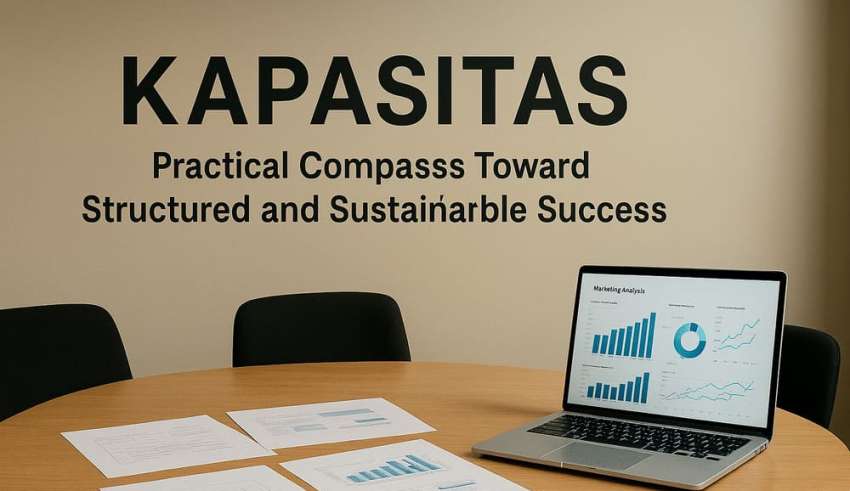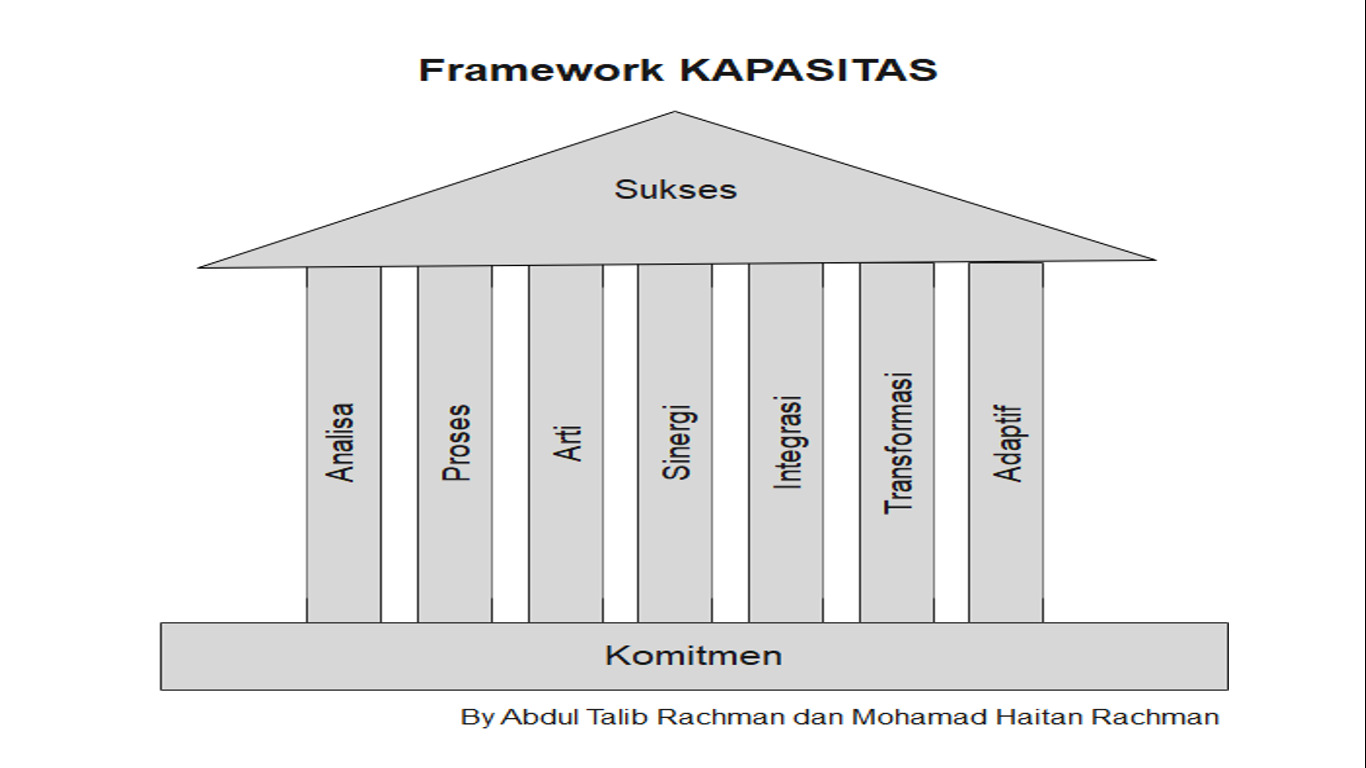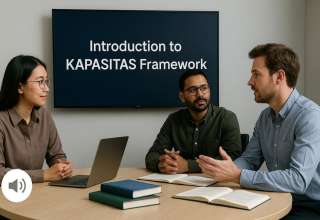
*) Gambar sebagai ilustrasi
KAPASITAS Framework: Practical Compass Toward Structured and Sustainable Success
By: Abdul Talib Rachman and Mohamad Haitan Rachman
A framework has the potential to create a significant impact if it can logically and functionally illustrate the interconnection among its components. This is the core strength of the KAPASITAS Framework—because each element within it is not merely a list of values or abstract jargon, but a sequence of interrelated steps within a real and coherent cause-and-effect structure.
This relational structure makes KAPASITAS more than just a conceptual model; it becomes an operational tool that can be used to analyze, design, and implement change at personal, team, or organizational levels. By understanding how each element influences the others, users can utilize the framework as a practical compass toward structured and sustainable success.
1. K — Commitment → The Foundation That Sets Direction
Cause: Without commitment, there is no starting point.
Effect: Strong commitment serves as the basis for consistent thinking and action.
Commitment is the fundamental foundation of any journey toward change or achievement. When an individual or organization is clearly committed to a vision, mission, or specific goals, energy, focus, and enthusiasm are aligned. Without commitment, all subsequent efforts will be fragile and easily disrupted by obstacles. Commitment explains why we begin and what keeps us moving forward. Therefore, it is the first causal element in this sequence.
2. A — Analysis → Determining Direction and Priorities
Cause: Commitment without understanding leads to blind action.
Effect: Analysis provides clarity on context, risks, and opportunities.
Once commitment is established, analysis becomes the next critical step. It functions as a navigational tool—helping to understand the situation, assess needs, identify challenges, and formulate strategies. Accurate analysis guides the next steps with precision. In contrast, the absence of analysis leads to wasted resources and misguided decisions.
3. P — Process → Turning Strategy into Action
Cause: Analysis without execution remains theoretical.
Effect: Process transforms ideas and strategies into tangible actions.
After analysis, a structured and directed workflow is needed—this is the role of process. Process is the bridge between knowledge and results. It organizes the rhythm of actions: who does what, when, and how. In team or organizational contexts, process governs responsibilities, workflows, and coordination. Without process, actions become sporadic and uncoordinated.
4. A — Meaning → Infusing Value into Action
Cause: Process without meaning becomes an empty routine.
Effect: Meaning provides intrinsic motivation and strengthens purpose.
A good process must be connected to meaning and purpose, so it does not remain purely technical. Meaning answers essential questions: “Who do we work for?” and “What impact does our work have?” When the workflow is infused with meaning, it produces passion, perseverance, and deep loyalty. In many cases, organizational failure is not due to a lack of process but due to the loss of meaning behind the process.
5. S — Synergy → Connecting Meaning with Collaboration
Cause: Meaning developed in isolation is limited.
Effect: Synergy amplifies impact through cross-functional collaboration.
The value of meaning increases when shared. Therefore, after discovering meaning, the next step is building synergy. Synergy generates new energy through interaction between individuals, teams, or institutions. When each party understands their purpose and contribution, synergy produces effective and cohesive collaboration. This is the power that magnifies the result of collective work over individual efforts.
6. I — Integration → Uniting Components into a System
Cause: Synergy without a system leads to chaos.
Effect: Integration combines elements into an efficient and effective system.
Synergy needs a structural framework to be sustainable. This is where integration plays a role—bringing together resources, information, technology, and work processes into a unified system. Integration enables collaborative work to operate within one ecosystem, not just through communication, but through interoperability and cohesive systems.
7. T — Transformation → The Result of Effective Integration
Cause: Strong integration creates opportunities for total change.
Effect: Transformation occurs when old systems are upgraded into sustainable improvements.
With an integrated system, transformation becomes possible—comprehensive change that brings improvement, renewal, or even a new identity. Transformation can happen at the individual level (mindset, behavior), team level (work culture), or organizational level (structure, vision, services). This is the phase where outcomes become visible and impact starts to be felt.
8. A — Adaptive → The Key to Sustaining Transformation
Cause: The world constantly changes, and transformation cannot be static.
Effect: Adaptability is essential to maintain relevance and continuity of change.
Transformation without adaptability is short-lived. Adaptive capacity becomes the defense mechanism against change dynamics. Adaptive individuals or organizations can quickly respond to challenges, learn new things, and adjust strategies to context shifts. Being adaptive is not only reactive but also proactive—seeking change before it arrives.
9. S — Success → The Accumulation of All Previous Steps
Cause: True success results from a holistic process, not a single factor.
Effect: The success achieved becomes sustainable, impactful, and meaningful.
The end of this sequence is success—not instant or accidental success, but one that is cumulative from commitment, analysis, process, meaning, synergy, integration, transformation, and adaptability. Thus, the KAPASITAS Framework clarifies that true success is not merely a final destination but the result of an evolutionary and meaningful journey of systematic efforts.
Conclusion: A Contextual and Operational Framework
By understanding that each KAPASITAS element is interconnected through cause and effect, this framework becomes highly contextual (adaptable to real-life conditions) and operational (translatable into concrete and measurable actions).
This framework is suitable for:
- Individuals: as a tool for self-reflection and personal development planning
- Teams: as a guide for collaboration and performance evaluation
- Organizations: as a driver of long-term transformation
KAPASITAS is not just an acronym—it is a cycle of continuous improvement that can be applied repeatedly in various situations. This is its advantage—simple yet profound, flexible yet focused.
If implemented consistently, KAPASITAS can become a work culture and mindset that creates profound impact for individuals and institutions alike.
If you have any questions about the training, mentoring, planning, and development services we offer—or if you are interested in collaboration—please contact us at: haitan.rachman@inosi.co.id






